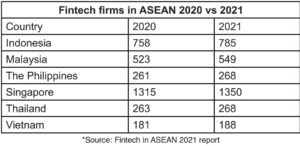
01 Dec Digital financial services get a pandemic boost
The coronavirus outbreak and the extended lockdowns had a significant impact on the financial systems of the world. With restricted mobility and the lack of access to traditional services, finance moved online. Wallets became digital. Virtual payments replaced cash. Much like the rest of the world, the ASEAN region, too, felt its effects.
With the threat of virus-related emergencies looming large, people wanted to conserve money and keep cash to themselves. Digital modes, in this, became the go to method of transaction. Solutions such as Buy-Now-Pay-Later (BNPL) gained popularity.
In 2020, 55% of new e-commerce users chose BNPL to pay for their online shopping, according to a survey by Kredivo-Katadata Insights Center. It showed that 41% of customers chose BNPL to keep their monthly cash flow under control.
As new payment systems gained traction, the number of e-commerce customers multiplied rapidly. A joint report by Meta (formerly Facebook) and Bain & Co. said that digital consumers in Southeast Asia will reach 350 million by the end of this year.
In Indonesia, for instance, the number of digital consumers has already shown a spurt in growth. The country had 144 million digital consumers in 2020. The number of users is expected to go up to 165 million by the end of 2021, marking a growth of 15%.
In countries such as the Philippines, Malaysia, and Vietnam, digital wallets became people’s preferred payment method, accelerating their adoption. Indonesia recorded the highest growth followed by Vietnam (8%), Malaysia (5%), Philippines (5%), Singapore (5%), and Thailand (2%). The report added that by 2026, Southeast Asia’s digital consumer population is expected to reach around 380 million.
The payments landscape
Few months into the pandemic, it was clear that this digital shift was definitive, and had permanently changed the way citizens pay. Following this, central banks of the region soon kicked into action. Their thrust was on localisation and customer safety.
With the shift, fintech firms gained. A joint report by UOB, PwC and Singapore Fintech Association showed that funding has rebounded to reach a record high of US$3.5 billion in ASEAN, more than triple the amount seen over 2020.
This funding was driven by 13 mega-rounds (classified as funding rounds of at least US$100 million),
accounting for more than half of total FinTech funding in ASEAN.
Here, Singapore and Thailand were the two most prominent countries in the region where almost all fintech categories received funding.
The report also said that the highest funded FinTechs are from the payments space, as ASEAN’s adoption of digital payments continues apace.
From the top 10 funded list this year, seven firms are in the unicorn club (startups valued at over US$1 billion): Grab Financial Group, VNPay, NIUM, GCash’s operator Mynt, Ascend Money, Xendit, and Matrixport.
The same report said that payments continue to lead the type of fintech firms in most ASEAN-6 countries, with the exception of Singapore. In Singapore, cryptocurrency firms came in top at 25% of total fintech firms while in Thailand, alternative lending firms led at 21%.
Indonesia
In January 2021, Indonesia announced the consolidation of regulations on payment systems. Under these rules, non-bank payment services firms need to have 15% Indonesian ownership. These rules envisaged higher local control and classification based on the transaction size, complexity, and interconnectivity.
The market saw the first signs of consolidation when e-commerce platform Tokopedia, which owns payments firm OVO, merged with ride-hailing startup Gojek to form the GoTo Group.
Indonesia also has a Payments Blueprint 2025 to help the country navigate these new waters. Under this, the country plans to open up financial access to 83.1 million unbanked people through digitisation. There will also be an interlinking of banks and fintech providers to reduce risks of shadow banking.
Vietnam and the Philippines mirrored these moves as well.
The Philippines
In the island country, the thrust has been to improve connectivity and deepen the penetration of digital financial services.
As a part of this plan, the country’s central bank issued a circular asking the designated payment systems to adopt the Principles for Financial Market Infrastructure (PFMI). As per these rules, the payment provider will have to bear responsibility for settlement risks and ensure a secure flow of funds between parties.
This was at a time when there was a 5,000% surge in digital payments in the Philippines amidst the pandemic, according to Bangko Sentral ng Pilipinas Governor Benjamin Diokno.
Like its peers, the Philippines, too, saw a rise in BNPL schemes. Fintechs tapped the younger generation, people with aspirations who may not have adequate funds. As of 2020, seven out of 10 Filipinos are mobile internet users, according to WeAreSocial’s report.
Vietnam
At the eastern edge of Southeast Asia, Vietnam has been making a slew of changes in its payment systems for the past two years to regulate those operating and using e-wallets.
From January 2020, new norms mandate that detailed customer information must be captured at the time of registration. Electronic wallets also have to be linked to a bank account or debit card for better traceability.
Vietnam is among the top 10 countries with the largest number of smartphone users. The country, as of 2021, has a staggering 61.3 million users. To cater to this growing market and foster innovation, the government is planning to launch a fintech sandbox.
This will allow fintech to experiment with new payment technology in a closed group. And based on the response, mass-market implementation will be permitted.
A government statement said that Vietnam’s digital economy has a total value of about $14 billion and is expected to reach $52 billion by 2025, with an average growth rate of 29% from now to 2025. In this region, the Meta-Bain report said that average spending per customer will grow by 60% from $238 per person at the end of 2020 to $381 by the end-2021.
In the last few years, social media videos have proven to be the most likely avenue for finding new products. Since current payment systems rules in the ASEAN do not cover these platforms so far, it is likely that the next phase of regulation will revolve around these websites.
What’s the way forward?
Be it digital wallets, BNPL schemes or other modes of virtual payments, the explosion of e-payments in ASEAN is set to continue.
In fact, fintech firms and banks are in stiff competition with each other to catch the unbanked and young customers. Fintech startups, in particular, want to woo the 1 billion unbanked customers who are often ignored by the traditional banking setup.
The pandemic also sped up the adoption of digital payments by customers who otherwise preferred to stay away.
To cater to the changing needs, banks have also turned virtual. For instance, the Philippines’ largest bank, BDO, launched its e-wallet BDO in March. And, the country’s banking regulator is further tightening rules for such operators.
As the ASEAN economies become integrated, it will be essential to develop payment solutions that are cross-border and can adapt to the ever changing regulatory regimes. In this scenario, every stakeholder will have a role to play, be it banks, payment aggregators, or fintech startups.
A 2020 McKinsey report said that just as the current environment gives Asia an unprecedented opportunity to reduce its reliance on cash, increased digitization will also spur a shakeout in physical infrastructure.
It said that this trend will lead to reductions of over 20% in branch and ATM networks. As demand for cash declines, banks could also play a service provider role for digital currencies by providing settlement facilities. This is the payments future that ASEAN is heading towards.

